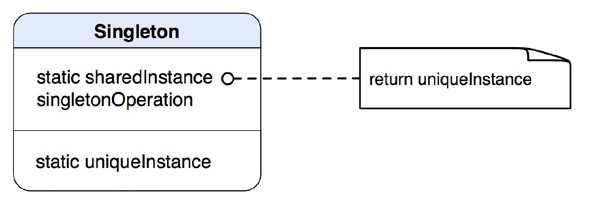标签:
单例的意思从字面上就可以略知一二,所谓单例就是确保在程序运行过程中只创建一个对象实例。可以用于需要被多次广泛或者说多次使用的资源中,比如我们常见的网络请求类、工具类以及其它管理类等。比如我iOS开发中常见的系统单例[UIApplication sharedApplication]、[NSUserDefaults standardUserDefaults]等。在iOS开发中,单例模式是非常有用的一种设计模式。如下图,是一个简单的例模式的UML类图。

一、使用单例模式的作用
它可以保证某个类在程序运行过程中最多只有一个实例,也就是对象实例只占用一份内存资源。

二、单例模式的三个要点:
1. 该类有且只有一个实例;
2. 该类必须能够自行创建这个实例;
3. 该类必须能够自行向整个系统提供这个实例。
三、为什么需要使用单例
1.节省内存开销。如果某个对象需要被多个其它对象使用,那可以考虑使用单例,因为这样该类只使用一份内存资源。
2.使用单例,可以确保其它类只获取类的一份数据(变量值)。
四、单例模式优缺点
优点
1、提供了对唯一实例的受控访问。
2、由于在系统内存中只存在一个对象,因此可以节约系统资源,对于一些需要频繁创建和销毁的对象单例模式无疑可以提高系统的性能。
3.因为单例模式的类控制了实例化的过程,所以类可以更加灵活修改实例化过程。
缺点
1、由于单利模式中没有抽象层,因此单例类的扩展有很大的困难。
2、单例类的职责过重,在一定程度上违背了“单一职责原则”。
五、单例的实现
基本步骤:
(1) 为单例对象创建一个静态实例,可以写成全局的,也可以在类方法里面实现,并初始化为nil;
(2) 实现一个实例构造方法,检查上面声明的静态实例是否为nil,如果是,则创建并返回一个本类的实例;
(3) 重写allocWithZone方法,用来保证其他人直接使用alloc和init试图获得一个新实力的时候不产生一个新实例;
(4) 适当实现copyWithZone,mutableCopyWithZone,非arc下还需要实现release和autorelease方法。
下面我们来新建一个Singleton类,在Singleton.h中实现如下:
@interface Singleton : NSObject + (Singleton *) sharedInstance; @end
在Singleton.m添加如下内容:
@implementation Singleton static Singleton * sharedSingleton = nil; + (Singleton *) sharedInstance { if (sharedSingleton == nil) { sharedSingleton = [[Singleton alloc] init]; } return sharedSingleton; } @end
这样就创建一个简单的单例模式,实际上有一部分程序员也是这样实现的,但实际上这是一个不“严格”版本,在实际中使用,如果我们使用alloc,copy等方法创建对象时,依然会创建新的实例。而且如果多线程同时访问时候也会创建多个实例,因此这样做是非线程安全的。
下面我对Singleton.m的进行改进:
@implementation Singleton static id sharedSingleton = nil; + (id)allocWithZone:(struct _NSZone *)zone { if (_instace == nil) { static dispatch_once_t onceToken; dispatch_once(&onceToken, ^{ sharedSingleton = [super allocWithZone:zone]; }); } return sharedSingleton; } - (id)init { static dispatch_once_t onceToken; dispatch_once(&onceToken, ^{ sharedSingleton = [super init]; }); return sharedSingleton; } + (instancetype)sharedInstance
{
return [[self alloc] init];
}
+ (id)copyWithZone:(struct _NSZone *)zone
{
return sharedSingleton;
}
+ (id)mutableCopyWithZone:(struct _NSZone *)zone
{
return sharedSingleton;
}
@end
这是一个比较完整的单例实现,这样在我们init,alloc,copy,mutableCopy时,都能保证只创建唯一单例。
六、把单例抽取成宏
有时候我们一个程序会有多个单例,如果我们每个都去是有上面的代码,未免有些麻烦,因此我们可以讲上面的代码定义为宏,并保存在一个新文件中,然后就可以再任何需要实现单例模式的类中简单添加一两行代码就可以了。
1.创建一个头文件Singleton.h,并添加如下代码:
// 帮助实现单例设计模式 // .h文件的实现 #define SingletonH(methodName) + (instancetype)shared##methodName; // .m文件的实现 #if __has_feature(objc_arc) // 是ARC #define SingletonM(methodName) static id _instace = nil; + (id)allocWithZone:(struct _NSZone *)zone { if (_instace == nil) { static dispatch_once_t onceToken; dispatch_once(&onceToken, ^{ _instace = [super allocWithZone:zone]; }); } return _instace; } - (id)init { static dispatch_once_t onceToken; dispatch_once(&onceToken, ^{ _instace = [super init]; }); return _instace; } + (instancetype)shared##methodName { return [[self alloc] init]; } + (id)copyWithZone:(struct _NSZone *)zone { return _instace; } + (id)mutableCopyWithZone:(struct _NSZone *)zone { return _instace; } #else // 不是ARC #define SingletonM(methodName) static id _instace = nil; + (id)allocWithZone:(struct _NSZone *)zone { if (_instace == nil) { static dispatch_once_t onceToken; dispatch_once(&onceToken, ^{ _instace = [super allocWithZone:zone]; }); } return _instace; } - (id)init { static dispatch_once_t onceToken; dispatch_once(&onceToken, ^{ _instace = [super init]; }); return _instace; } + (instancetype)shared##methodName { return [[self alloc] init]; } - (oneway void)release { } - (id)retain { return self; } - (NSUInteger)retainCount { return 1; } + (id)copyWithZone:(struct _NSZone *)zone { return _instace; } + (id)mutableCopyWithZone:(struct _NSZone *)zone { return _instace; }
2.这样我们在需要实现单例模式的类中轻易就可以实现单例模式了,假设有个工具类MJSoundTool。因此就可以这么做实现单例模式。
头文件MJSoundTool.h
#import <Foundation/Foundation.h> #import "Singleton.h" @interface MJSoundTool : NSObject //+ (instancetype)sharedSoundTool; SingletonH(SoundTool) @end
实现文件MJSoundTool.m
#import "MJSoundTool.h" @implementation MJSoundTool SingletonM(SoundTool) @end
是不是很方便呢,我们以后需要设计单例的时候就可以直接使用该单例宏文件了。下载地址:单例宏Singleton.h。好了,单例模式就介绍到这里。??
标签:
原文地址:http://www.cnblogs.com/JackieHoo/p/5050010.html